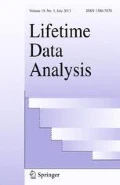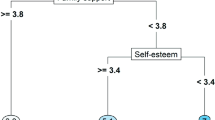Abstract
Semicompeting risks data, where a subject may experience sequential non-terminal and terminal events, and the terminal event may censor the non-terminal event but not vice versa, are widely available in many biomedical studies. We consider the situation when a proportion of subjects’ non-terminal events is missing, such that the observed data become a mixture of “true” semicompeting risks data and partially observed terminal event only data. An illness–death multistate model with proportional hazards assumptions is proposed to study the relationship between non-terminal and terminal events, and provide covariate-specific global and local association measures. Maximum likelihood estimation based on semiparametric regression analysis is used for statistical inference, and asymptotic properties of proposed estimators are studied using empirical process and martingale arguments. We illustrate the proposed method with simulation studies and data analysis of a follicular cell lymphoma study.


Similar content being viewed by others
References
Andersen P, Keiding N (2002) Multi-state models for event history analysis. Stat Methods Med Res 11(2):91–115
Andersen P, Hansen L, Keiding N (1991) Non-and semi-parametric estimation of transition probabilities from censored observation of a non-homogeneous markov process. Scand J Stat 18:153–167
Andersen P, Borgan Ø, Gill R, Keiding N (1993) Statistical models based on counting processes. Springer, New York
Andersen P, Esbjerg S, Sørensen T (2000) Multi-state models for bleeding episodes and mortality in liver cirrhosis. Stat Med 19(4):587–599
Breslow N (1975) Analysis of survival data under the proportional hazards model. Int Stat Rev 43(1):45–57
Chen Y (2009) Weighted Breslow-type and maximum likelihood estimation in semiparametric transformation models. Biometrika 96(3):591–600
Chen Y (2010) Semiparametric marginal regression analysis for dependent competing risks under an assumed copula. J R Stat Soc B 72(2):235–251
Chen YH (2012) Maximum likelihood analysis of semicompeting risks data with semiparametric regression models. Lifetime Data Anal 18(1):36–57
Chen K, Jin Z, Ying Z (2002) Semiparametric analysis of transformation models with censored data. Biometrika 89(3):659–668
Clayton D (1978) A model for association in bivariate life tables and its application in epidemiological studies of familial tendency in chronic disease incidence. Biometrika 65(1):141
Cook R, Lawless J (2007) The statistical analysis of recurrent events. Springer, New York
Fine J, Gray R (1999) A proportional hazards model for the subdistribution of a competing risk. J Am Stat Assoc 94:496–509
Fine J, Jiang H, Chappell R (2001) On semi-competing risks data. Biometrika 88(4):907–919
Govindarajulu U, Lin H, Lunetta K, D’Agostino R (2011) Frailty models: applications to biomedical and genetic studies. Stat Med 30:2754–2764
Hougaard P (2000) Analysis of multivariate survival data. Springer, New York
Hsieh J, Wang W (2008) Regression analysis based on semicompeting risks data. J R Stat Soc B 70(1):3–20
Huang X, Zhang N (2008) Regression survival analysis with an assumed copula for dependent censoring: a sensitivity analysis approach. Biometrics 64(4):1090–1099
Kalbfleisch J, Prentice R (2002) The statistical analysis of failure time data, vol 360. Wiley-Interscience, Hoboken
Kosorok M (2008) Introduction to empirical processes and semiparametric inference. Springer, New York
Little R, Rubin D (2002) Statistical analysis with missing data, vol 333. Wiley, New York
Nielsen G, Gill R, Andersen P, Sørensen T (1992) A counting process approach to maximum likelihood estimation in frailty models. Scand J Stat 19:25–43
Oakes D (1989) Bivariate survival models induced by frailties. J Am Stat Assoc 84(406):487–493
Peng L, Fine J (2007) Regression modeling of semicompeting risks data. Biometrics 63(1):96–108
Pintilie M (2006) Competing risks: a practical perspective, vol 22. Wiley, Chichester
Shu Y, Klein J, Zhang M (2007) Asymptotic theory for the Cox semi-Markov illness–death model. Lifetime Data Anal 13(1):91–117
Tsodikov A (2003) Semiparametric models: a generalized self-consistency approach. J R Stat Soc B 65(3):759–774
Van Der Vaart A, Wellner J (1996) Weak convergence and empirical processes. Springer, New York
Wang W (2003) Estimating the association parameter for copula models under dependent censoring. J R Stat Soc B 65(1):257–273
Xu J, Kalbfleisch J, Tai B (2010) Statistical analysis of illness–death processes and semicompeting risks data. Biometrics 66(3):716–725
Zeng D, Lin D (2006) Efficient estimation of semiparametric transformation models for counting processes. Biometrika 93(3):627–640
Zeng D, Lin D (2007) Maximum likelihood estimation in semiparametric regression models with censored data. J R Stat Soc B 69(4):507–564
Zeng D, Lin D (2010) A general asymptotic theory for maximum likelihood estimation in semiparametric regression models with censored data. Stat Sin 20(2):871
Zheng M, Klein J (1995) Estimates of marginal survival for dependent competing risks based on an assumed copula. Biometrika 82(1):127
Acknowledgments
We are grateful to the associate editor, and two referees for their helpful comments, which have greatly improved the manuscript. This research was supported by National Cancer Institute Grant CA157224 (CISNET).
Author information
Authors and Affiliations
Corresponding author
Electronic supplementary material
Below is the link to the electronic supplementary material.
Rights and permissions
About this article
Cite this article
Hu, C., Tsodikov, A. Joint modeling approach for semicompeting risks data with missing nonterminal event status. Lifetime Data Anal 20, 563–583 (2014). https://doi.org/10.1007/s10985-013-9288-y
Received:
Accepted:
Published:
Issue Date:
DOI: https://doi.org/10.1007/s10985-013-9288-y




